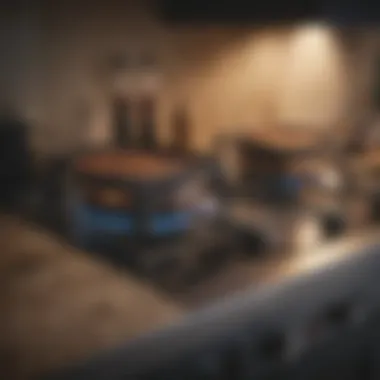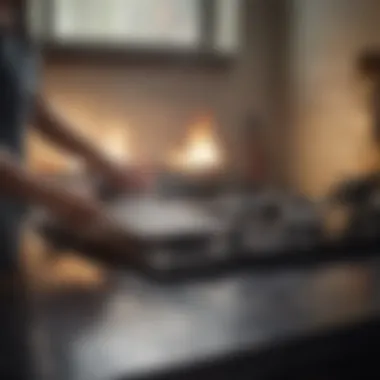An Efficient Guide to Cleaning Flat Top Stoves


Intro
Maintaining a flat top stove is essential for both functionality and visual appeal. Over time, residues from cooking can build up, affecting performance and the overall look of your kitchen. This guide aims to provide a thorough understanding of effective methods to clean flat top stoves. By mastering these techniques, you will not only enhance the longevity of the appliance but also ensure a hygienic cooking environment.
In this guide, we will cover practical cleaning methods, necessary tools, and tips for maintaining a pristine appearance. Whether you are an everyday cook or someone who values the aesthetic of your kitchen, this information is tailored to meet your needs.
Understanding Flat Top Stoves
Flat top stoves have become a staple in many kitchens, both for their aesthetic appeal and their practical functionality. Understanding the unique features and characteristics of flat top stoves is essential for effective maintenance and cleaning. This section will explore their definition, common materials, and advantages, allowing users to appreciate these appliances and the care they require to remain in optimal condition.
Definition and Features
A flat top stove typically refers to a cooking surface that is smooth and even, made from glass, ceramic, or a specially designed metal alloy. Unlike traditional coil stoves, flat top models offer a sleek profile and modern appearance. They may feature induction cooking technology as well, providing rapid heat and precise temperature control.
Notably, these stoves come with features such as touch controls, digital displays, and safety locks, which enhance user experience. Understanding their design helps users appreciate both their beauty and their needs, creating a foundation for effective cleaning practices.
Common Materials Used
The surfaces of flat top stoves are typically made from materials like glass-ceramic or polished stainless steel. Glass-ceramic is known for its durability and resistance to thermal shock, making it a popular choice for modern stoves. It is easy to clean but can scratch if harsh tools are used.
Stainless steel, while appealing, is prone to smudges and fingerprints, requiring regular maintenance. Knowing the material helps users choose the appropriate cleaning methods and products to maintain the appearance of their stove.
Advantages of Flat Top Stoves
Flat top stoves offer several advantages that make them a preferred choice in many households. Firstly, their smooth surface allows for easy cleaning. There are no grooves or crevices for food debris to get lodged in, which simplifies routine maintenance.
Moreover, sleek designs contribute to a modern kitchen aesthetic, appealing to those interested in interior design. Flat top stoves also tend to cook food evenly and quickly, which enhances the cooking experience. In terms of energy efficiency, induction models use less energy than traditional electric stoves, benefiting both the environment and the user’s electricity bill.
In summary, understanding flat top stoves entails recognizing their unique features, the materials they are constructed from, and the compelling advantages they offer. This knowledge lays the groundwork for developing effective cleaning habits that not only maintain their functionality but also extend the longevity of the appliance.
Preparing for Cleaning
Cleaning a flat top stove is not merely a task, but an essential part of household maintenance that can significantly influence your cooking experience and the appliance's longevity. Before diving into extensive cleaning methods, it is critical to prepare adequately. This preparation ensures efficiency during the cleaning process and helps avoid common pitfalls that can lead to damage or ineffective cleaning.
One important consideration is to assess the current state of the stove. It may have varying levels of grime or debris based on usage frequency and type of cooking. Understanding the situation allows for a more tailored approach, whether it's routine maintenance or tackling more complex stains.
Additionally, having a clear, organized plan fosters a sense of readiness and minimizes interruptions. By taking the time to prepare, you can execute your cleaning tasks with precision and faster outcomes.
Gathering Cleaning Supplies
The first step in preparing for the cleaning process is to gather the necessary supplies. Armed with the right tools and materials makes a significant difference in both the ease and effectiveness of your cleaning efforts. Standard supplies for cleaning flat top stoves include:


- Soft cloths or paper towels
- Non-abrasive sponges or scrubbers
- A flat edge scraper designed for glass or ceramic surfaces
- Commercial stove cleaner or a DIY solution like vinegar and baking soda
- Water in a spray bottle
A crucial point is to avoid harsh chemical cleaners that may scratch or damage the surface of your stove. Choosing products specifically made for flat top stoves can enhance not only the cleaning process but also preserve the aesthetic quality of your cooking appliance.
Ensuring Safety First
Before you begin cleaning, safety is paramount. Ensuring safety first protects both you and your stove. Here are several essential safety measures to consider:
- Allow the Stove to Cool: Always make sure the stove surface is completely cool before attempting to clean. This prevents burns and ensures effective cleaning without causing the cleaner to evaporate too quickly.
- Wear Protective Gear: Consider wearing gloves, especially when using stronger cleaning solutions. While many commercial cleaners are effective, they can be irritating to the skin.
- Read Labels: Take a moment to read the labels on cleaning products carefully. Some substances react poorly with specific materials. Understanding their use will help avoid accidental damage.
- Ventilation: Ensure the area is well-ventilated, especially if using any cleaning agent with strong fumes. Open windows or turn on fans to keep the air fresh.
Following safety precautions helps create a secure environment for your cleaning efforts, ultimately leading to more effective outcomes.
Taking these preliminary steps not only primes the flat top stove for cleaning but also sets a positive tone for the overall process. The next stages of cleaning can then be approached with confidence and clarity.
Basic Cleaning Techniques
Effective cleaning techniques form the backbone of maintaining a flat top stove. Regular upkeep is essential not just for aesthetic purposes but also for preserving functionality. In this section, we will explore key methods that prevent the build-up of grime and stains while extending the life of your appliance. Understanding these techniques ensures that your cooking surface remains in optimal condition, ready for perfect culinary creations.
Wipe Down Routine
A fundamental part of stove maintenance is establishing a regular wipe down routine. This process helps remove food residues and spills that can tarnish the surface. Using a soft cloth or sponge, moisten it with warm water or a mild detergent. Wipe the surface gently, ensuring to cover all areas, especially around burners where crumbs often gather.
- Frequency: Aim to perform the wipe down after each use to prevent stubborn stains from setting in.
- Avoid Scratching: It is crucial to use non-abrasive materials to avoid scratching the surface, which can lead to further complications like discoloration and reduced performance.
- Drying: After wiping, dry the surface with a clean, dry cloth to prevent water spots.
A consistent wipe down routine not only keeps your stove looking fresh but also enhances your cooking experience.
Using Scrapers and Sponges
For more stubborn residues and burnt-on food, using scrapers and sponges becomes necessary. Scrapers designed for flat top stoves can effectively lift tough stains without risking damage to the cooking surface.
- Choosing a Scraper: Select a scraper made of plastic or specially designed metal to ensure safety during cleaning.
- Technique: Hold the scraper at a shallow angle, applying light pressure. Move it in a single sweeping motion to dislodge food particles.
- Sponges: Use a non-scratch sponge for areas with lighter stains. Apply gentle pressure while cleaning in a circular motion, which helps lift residue without the risk of scratching.
Remember to always check the manufacturer’s guidelines regarding cleaning supplies to ensure compatibility and avoid voiding the warranty. By incorporating these basic cleaning techniques into your routine, you will prolong the life and maintain the appearance of your flat top stove.
Deep Cleaning Methods
Deep cleaning methods are crucial for maintaining the functionality and aesthetic of flat top stoves. Regular cleaning is essential to remove surface grime, but deeper cleaning addresses the residues and stains that threaten the surface integrity. Ignoring this task may lead to long-term discoloration or even damage to the heating elements beneath. Therefore, understanding effective deep cleaning methods can prevent costly repairs and enhance the overall kitchen experience.
Baking Soda and Vinegar Paste
Baking soda and vinegar are common kitchen staples known for their powerful cleaning abilities. To create a paste with these ingredients, mix equal parts of baking soda and vinegar until a thick consistency forms. This paste acts as an excellent abrasive cleaner, ideal for tackling stubborn stains and burnt-on food.


To use it, apply the paste directly onto the stained areas, allowing it to sit for at least 15 minutes. This wait time enables the mixture to break down the grime effectively. Afterward, scrub gently with a sponge or soft cloth. The mildly abrasive nature of baking soda, combined with the acidity of vinegar, allows for an efficient cleaning process without scratching the surface.
Key Benefits of Using This Method:
- Non-toxic: Safe for food areas, as it does not contain harsh chemicals.
- Cost-effective: Requires common household items, avoiding pricey commercial cleaners.
- Versatile: Can be used on various surfaces beyond flat top stoves, such as countertops.
Commercial Cleaners – When to Use
Commercial cleaners are designed for specific cleaning challenges, providing solutions for tougher stains and grease that homemade remedies might not address. However, it is important to select cleaners specifically formulated for flat top stoves, as the wrong type may cause damage.
Before using a commercial cleaner, check the manufacturer's instructions related to the stove. Some cleaners are not suitable for certain materials and may void warranties if used improperly. When dealing with particularly tough stains, such as burnt-on food or grease, a specialized cleaner can save time and energy.
Situations to Consider Commercial Cleaners:
- Heavy Build-up: If the stove surface has not been cleaned for an extended period.
- Burnt Food Residue: Particularly stubborn remnants that won't come off with standard cleaning.
- Convenience: When time is of the essence, and immediate results are necessary.
Addressing Stubborn Stains
Stubborn stains on flat top stoves can be quite frustrating. They not only affect the aesthetic appeal of the kitchen but can also influence the efficiency of cooking. Addressing these stains effectively is essential for maintaining both the function and form of the appliance. Using the wrong methods or products might even worsen the situation. A comprehensive approach is required for optimal removal. This section outlines the techniques needed to tackle these persistent marks, thereby enhancing the lifespan of your stove.
Identifying Stain Types
Before you can remove any stain, it is vital to identify its type. Common stains on flat top stoves include:
- Burnt Food Residue: Often sticky and challenging to dislodge.
- Grease Stains: Can appear shiny and are usually oily.
- Water Marks: Caused by water droplets left to dry.
- Mineral Deposits: White, chalky spots from hard water can develop.
Each stain type requires a specific method for effective removal. Recognizing the characteristics of a stain can greatly streamline the cleaning process.
Strategic Application of Cleaning Products
Once the stain type is identified, selecting the correct cleaning product is next.
- For Burnt Food Residue: Use a scraper designed for glass surfaces. Apply gentle pressure to avoid scratching, and follow up with a non-abrasive cleaner.
- For Grease Stains: A multi-surface spray can be effective. Spray directly on the stain and let it sit for a few minutes before wiping it off with a microfiber cloth.
- For Water Marks: A simple mixture of vinegar and water can help. Spray it on the affected area and wipe with a soft cloth.
- For Mineral Deposits: A baking soda and water paste can be useful. Apply the paste, let it sit, and then scrub gently to break down the buildup.
Important Note: Always test cleaning products on a small area before full application to prevent any potential damage.
Using Protective Coatings
After effectively removing stubborn stains, the application of a protective coating can help in future maintenance. These coatings create a barrier against spills and stains, making cleaning much easier.
- Cooktop Protectants: Available in most home improvement stores, these products can shield the surface from scratches and stains.
- Regular Applications: For best results, apply the protectant every few weeks or after deep cleaning. This will enhance the stove’s appearance and performance over time.


Maintaining a clean flat top stove does not end with the removal of stains. Implementing these practices will not only ensure a pleasant cooking environment but will also significantly prolong the life of your appliance.
Maintaining a Clean Flat Top Stove
Keeping a flat top stove clean is crucial for both its functionality and aesthetic appeal. Regular maintenance prevents the build-up of stubborn stains, grease, and burnt food residues that can detract from the overall beauty of a kitchen. Moreover, a clean stove enhances cooking performance, ensuring even heat distribution and preventing unpleasant odors that might transfer to your food.
Daily care involves simple routines that can significantly extend the lifetime of your appliance. Additionally, understanding the seasonal deep cleaning process can ensure thorough upkeep and often resonates with those who value a well-functioning kitchen. Providing tips and strategies for both daily and seasonal maintenance helps users stay proactive rather than reactive in their cleaning practices.
Daily Maintenance Tips
Maintaining a flat top stove on a daily basis helps to avoid more intensive cleaning in the future. Here are some effective daily maintenance tips:
- Wipe Down After Use: Always wipe surfaces immediately after cooking. Use a soft damp cloth or sponge to remove any spills or splatters.
- Avoid Abrasive Cleaners: Use mild soap or a designated cleaner to prevent scratches. Harsh chemicals can damage the surface.
- Use Cookware with Flat Bottoms: To minimize scratches, opt for pots and pans with smooth bottoms. This prevents any unintentional marks on the stove.
- Check for Burnt Food: Promptly remove burnt residue once the stove cools. Stubborn burns are easier to manage soon after they occur.
- Maintain a Dry Surface: Always ensure the stove is dry after cleaning. Moisture can lead to streaks and may trap dirt.
Seasonal Deep Cleaning Routine
Seasonal cleaning helps in removing any accumulated residues that regular maintenance might miss. Here’s how to implement a solid seasonal deep cleaning routine:
- Gather Necessary Supplies: Collect baking soda, vinegar, a soft cloth, non-abrasive scrubbers, and a commercial cleaner if needed.
- Disconnect the Power: For safety, always turn off the stove prior to extensive cleaning. Unplug it to ensure no accidental activation occurs during the cleaning process.
- Remove Food Particles: Start by scraping off large pieces of food. Use a scraper for stubborn areas, but handle it carefully to avoid damaging the surface.
- Apply a Cleaner: Mix baking soda with a bit of water to form a paste. Apply it on any stubborn stains and let it sit for 15 minutes. Afterward, scrub with a soft cloth.
- Rinse Thoroughly: Use a clean damp cloth to remove any residual cleaning solution. Ensure all products are completely wiped off.
- Dry the Surface: Lastly, wipe down the surface with a dry cloth to prevent water marks and maintain shine.
A consistent cleaning regimen will not only keep your stove looking good but also prevent the need for more substantial interventions down the road.
Frequently Asked Questions
In any guide, the section on frequently asked questions plays a vital role. It addresses common concerns and clarifies doubts that many readers might have. This section ensures that important information is easily accessible and reduces uncertainty. Often, cleaning processes can be daunting for some users, particularly those new to flat top stoves. Providing clear answers reflects the practical challenges people face, making the article more relatable and valuable.
What is the best way to remove burnt food?
Removing burnt food from a flat top stove requires a methodical approach. Begin by ensuring the stove is completely cool. You can use a flat edge scraper made specifically for ceramic or glass surfaces. Scraping gently at an angle is effective. It prevents damage to the surface while lifting stubborn residues. If residues are particularly stubborn, creating a paste of baking soda and water can help. Apply it directly to the area and let it sit for a few minutes. Afterward, use the scraper again to lift the softened food remnants. Follow up with a damp sponge to wipe away any residue.
Are there any cleaners to avoid?
Some cleaning products can be detrimental to flat top stoves. Avoid any cleaners that contain harsh abrasives or bleach. These can scratch the surface or leave behind residues that may interfere with cooking. Additionally, oven cleaners are not suitable for flat top surfaces, as they can be too harsh and may cause permanent damage. Always check the labels and ensure the cleaner is marked as safe for ceramic or glass cooktops. It is beneficial to stick with products specifically designed for this type of surface to maintain optimal appearance and functionality.
Epilogue
Cleaning flat top stoves not only increases their aesthetic appeal but also promotes longevity and functionality. In this article, we have explored several cleaning methods, essential tools, and maintenance tips. The key points detailed here aim to equip the reader with the knowledge needed to maintain their stove without causing damage.
The importance of understanding the correct cleaning techniques cannot be understated. Using the right materials and methods protects the surface, preventing scratches and further stains that are challenging to remove. Additionally, keeping your flat top stove clean enhances your cooking experience by ensuring a hygienic space and optimal performance.
Summary of Key Points
- Regular maintenance preserves the longevity of flat top stoves.
- Safe cleaning methods prevent scratches and damage.
- Supportive cleaning products can maximize results, such as baking soda and commercial cleaners.
- Stubborn stains require specific strategies, identifying each type for the most effective treatment.
- Daily upkeep can significantly reduce the need for deep cleaning.
Final Thoughts on Stovetop Care
Flat top stoves represent a blend of design and functionality. Their maintenance is a combination of aesthetic consideration and practical cooking needs. By adopting consistent cleaning habits and using the right tools, stove owners can maintain a visually appealing and effective cooking surface. Balance is important; regular cleaning meets both visual standards and practical requirements. A well-cared stove reflects positively on both the kitchen's overall appearance and the user's dedication to culinary excellence.







